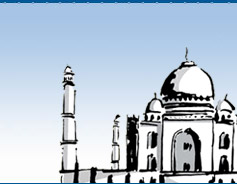
 |
|||||||||||||||||||
   |
|
|
|
Climate of India Indian
weather and climate conditions are very diverse and can reach extremes.
The climate of India is essentially a temperate one. India lies to the
north of Equator, so the southern part of India is usually much warmer
than the rest of India. Also, water bodies flank India on three sides
thus giving the peninsular region a maritime climate. The weather of
India changes every now and then thus giving the people the much-needed
relief from the extreme weather conditions. Check out the main seasons
of India and decide when is the best time for your visit. Indian
weather and climate conditions are very diverse and can reach extremes.
The climate of India is essentially a temperate one. India lies to the
north of Equator, so the southern part of India is usually much warmer
than the rest of India. Also, water bodies flank India on three sides
thus giving the peninsular region a maritime climate. The weather of
India changes every now and then thus giving the people the much-needed
relief from the extreme weather conditions. Check out the main seasons
of India and decide when is the best time for your visit.Summer Season The duration of summer in India is from March to June. It is mildly pleasant in March, a bit uncomfortable in April, hot in May and scorching in June. The temperature in the plains of northern India can go upto 45o Celsius. The southern region is equally hot. This is the time when people pack their bags and head off to the hills and valleys where it is relatively cooler. Monsoons The Monsoon season in India usually lasts from the month of June to that of September. During this time, most of the areas in the country get their share of rainfall, which leaves a hue of greenery in its wake. The South West Monsoon enters India through the coast of Kerala and Andaman & Nicobar Islands and passing through Mumbai, central India and eastern India, reaches other parts of North and N West India. During the months of October to November, some parts of South India experience rains in the form of the northeast monsoon. Winter Season The winters in India can get really chilly. It becomes bone chilling during the months of November to February. The northern part of India experiences harsh weather conditions with cold wave sweeping almost entire northern regions and central parts of India. The hilly areas experience sub-zero temperature conditions. |
 Taj Mahal Tour Taj Mahal Tour Rajasthan Tours Rajasthan Tours Kerala Tours Kerala Tours Kashmir Tours Kashmir Tours Tamilnadu Tours Tamilnadu Tours Adventure Tours India Adventure Tours India Beach Tours India Beach Tours India Desert Tours India Desert Tours India Pilgrimage Tours India Pilgrimage Tours India Ayurveda Tours India Ayurveda Tours India Buddhist Tours India Buddhist Tours India Temple
Tours India Temple
Tours India Sculpture Tours India Sculpture Tours India Golden Triangle Tour Golden Triangle Tour India Heritage Tours India Heritage Tours Hill Tours India Hill Tours India Honeymoon Tours India Honeymoon Tours India Kerala Backwaters Tour Kerala Backwaters Tour India Train Tours India Train Tours Trekking Tours India Trekking Tours India India Wildlife Tours India Wildlife Tours Karnataka Tour Karnataka Tour Nepal Tour Nepal Tour Orissa Tour Orissa Tour Gujarat Tour Gujarat Tour Andhra Pradesh Tour Andhra Pradesh Tour Maharashtra Tour Maharashtra Tour Chardham Tour Chardham Tour  Golden Chariot Golden Chariot Himachal Pradesh Tour Himachal Pradesh Tour Sikkim Tour Sikkim Tour Madhya Pradesh Tour Madhya Pradesh Tour
|
||||||||||||||||||||
| |||||||||||
Copyright © BharatOnline.com | |||||||||||